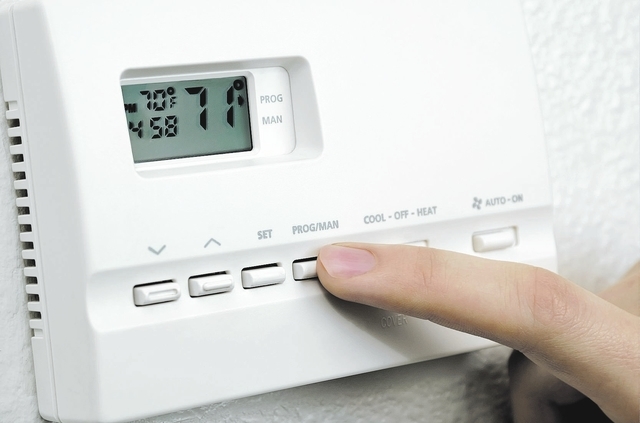Programmable thermostat reduces power bill
Q: I recently moved into a new house and received my first power bill. I was shocked at the amount and was sure there had been a mistake. I was wrong. A friend suggested I replace my thermostat with one that is programmable. What are the particulars on this job?
A: Your friend is right. Manufacturers claim that programmable thermostats can cut energy costs by as much as 35 percent. I don’t know how this applies to Southern Nevada, but it will help lower costs if it’s programmed correctly.
Different people have different theories about using an air conditioner.
My brother, for instance, turns the thermostat completely off while he’s at work. When he returns home, he’s greeted by a blast of 95 degree air and turns the thermostat back on. I’m sure the air conditioner runs nonstop until the wee hours of the morning to bring the temperature back down.
Other people set their thermostat and leave it alone. However, cooling your house for an entire day while you’re away doesn’t seem like a good idea either.
A programmable thermostat splits the difference. You program it to cool the air to your comfort when you’re at home, and then when you leave for work, it will adjust to a slightly higher temperature setting.
Programmable thermostats start at around $25 at a home center, and they take about 30 minutes to install. Saving money doesn’t get any easier. You might check with your local power company to see if there are any rebates available.
If you have a heat pump, a home center likely won’t carry the proper thermostat for your system. You’ll need to try a specialty wholesaler.
To install the thermostat, turn off the power to the air conditioning and heating system at the main panel. Remove the cover from the old thermostat.
There are a couple of screws that hold the thermostat body to the wall. Remove these screws and gently pull the thermostat away from the wall.
Depending upon your system, there will be several wires coming from the wall that are attached to various terminals on the thermostat. As you carefully unscrew the wires from each terminal, label the wire with masking tape to identify the terminal to which it was attached. Each terminal has a letter next to it, so write that letter on the masking tape that you attach to each wire. Don’t worry, we’re only talking about three to five wires.
I also recommend taping wires to the wall, because fishing them out of the wall will really make you sweat. Thread the wires through the opening of the new thermostat and mount the thermostat to the wall with the screws provided.
Following the manufacturer’s instructions, connect the wires to the terminals on the new thermostat. Install the batteries and snap the thermostat’s housing onto the base. All that is left is to turn the power back on and program the unit.
I’ve spoken with several professionals, ranging from air-conditioning contractors to a Nevada Power representative, about the most efficient way to program a thermostat. The consensus is to set it 2 to 4 degrees higher when you’re not at home than what you set it for while you’re at home. For example, if you prefer the temperature to be 78 degrees when you’re at home, program the thermostat to turn on the air conditioner when the temperature reaches 80 to 82 degrees.
Personally, I raise my ideal temperature by 4 degrees when I am gone. You can also raise the temperature inside the house slightly and use ceiling fans.
Mike Klimek is a licensed contractor and president of Pro Handyman Corp. Questions may be sent by email to: questions@pro-handyman.com. Or, mail to: P.O. Box 96761, Las Vegas, NV 89193. His Web address is: www.pro-handyman.com.




























